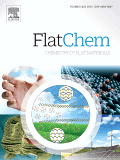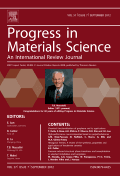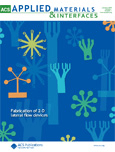
JOURNAL OF POROUS MATERIALS
Scope & Guideline
Transforming Insights into Porous Material Applications
Introduction
Aims and Scopes
- Synthesis of Porous Materials:
The journal features research on various synthetic routes for creating porous materials, including sol-gel processes, hydrothermal methods, and template-assisted techniques, emphasizing new approaches and improvements in existing methods. - Characterization Techniques:
Research articles often highlight advanced characterization techniques such as SEM, TEM, BET surface area analysis, and XRD, providing insights into the structural and morphological properties of porous materials. - Applications in Catalysis:
A significant focus is on the application of porous materials in catalytic processes, exploring their roles as catalysts or supports for catalytic reactions in chemical transformations, including biomass conversion and environmental remediation. - Environmental Remediation:
The journal publishes studies on the use of porous materials for environmental applications, particularly in the adsorption and removal of pollutants such as heavy metals and organic dyes from water. - Energy Storage and Conversion:
Research on porous materials in energy storage systems, such as supercapacitors and batteries, is prevalent, showcasing their potential to enhance performance through improved surface area and porosity. - Biomedical Applications:
The journal also covers the development of porous materials for biomedical applications, including drug delivery systems and tissue engineering scaffolds, highlighting their biocompatibility and functionality.
Trending and Emerging
- Biomass-Derived Porous Materials:
There is a growing trend towards the development of porous materials derived from biomass, emphasizing sustainability and environmental friendliness in material synthesis, which aligns with global efforts towards greener technologies. - Nanostructured and Hybrid Materials:
Research increasingly focuses on nanostructured and hybrid materials that combine multiple functionalities, such as enhanced catalytic activity and improved adsorption capabilities, showcasing innovative approaches to material design. - Smart and Responsive Materials:
The emergence of smart materials that respond to environmental stimuli (e.g., temperature, pH) for drug delivery and environmental applications is gaining traction, indicating a shift towards multifunctional porous systems. - Metal-Organic Frameworks (MOFs):
MOFs have become a prominent theme, with extensive research on their synthesis, functionalization, and applications in gas storage, separation, and catalysis, reflecting their versatility and high surface area. - Advanced Characterization Techniques:
The use of advanced characterization techniques, including in-situ studies and computational modeling, is on the rise, allowing for deeper insights into the properties and behaviors of porous materials.
Declining or Waning
- Traditional Zeolite Studies:
Research focused solely on traditional zeolite structures and their applications has seen a decrease, as newer materials and composites gain attention for their enhanced properties and functionalities. - Single-Component Systems:
There has been a noticeable decline in studies involving single-component porous materials, with a shift towards hybrid and composite materials that integrate multiple functionalities for improved performance. - Conventional Adsorbents:
The publication of papers centered on conventional adsorbents for pollutant removal has decreased, as researchers increasingly explore novel materials with enhanced selectivity and efficiency. - Passive Environmental Applications:
Research on passive applications of porous materials, such as basic filtration or adsorption without functionalization or modification, has waned in favor of more sophisticated and engineered solutions.
Similar Journals

Polymer-Plastics Technology and Materials
Advancing the Future of Polymer SciencePolymer-Plastics Technology and Materials is a premier academic journal published by Taylor & Francis Inc., dedicated to the dynamic fields of chemical engineering, materials chemistry, and polymers and plastics. With an impact factor that reinforces its reputation, this journal is strategically indexed in Scopus, ranked notably within its categories (Q2), showcasing its influence and relevance in the academic community. Since its inception in 2019, the journal has served as an essential platform for researchers, professionals, and students to disseminate innovative studies and advancements in polymer science and materials technology. As an Open Access publication, it ensures that cutting-edge research is accessible to a global audience, fostering collaboration and knowledge sharing in the material sciences. Located in the United Kingdom, Polymer-Plastics Technology and Materials continues to enhance the dialogue within the industry, addressing critical challenges and exploring emerging trends that shape the future of polymer and plastics technologies.

Advanced Materials Interfaces
Elevating Materials Science through Open Access InsightsAdvanced Materials Interfaces is a premier journal dedicated to the exploration and advancement of materials science, with particular emphasis on the interfacial phenomena that govern the behavior of materials in various engineering applications. Published by WILEY in the United Kingdom, this Open Access journal, established in 2014, has quickly ascended to a Q1 category ranking in both Mechanical Engineering and Mechanics of Materials as of 2023, reflecting its significant influence and excellence in the field. With impressive Scopus Ranks, such as #81 out of 672 in Mechanical Engineering and #58 out of 398 in Mechanics of Materials, it serves as a vital resource for researchers and practitioners aiming to push the boundaries of materials innovation. The journal provides unrestricted access to its cutting-edge research, promoting collaboration and dissemination of knowledge among the global scientific community, solidifying its role as a vital contributor to the ever-evolving landscape of materials engineering.

Carbon Letters
Fostering Excellence in Ceramics and Composites Research.Carbon Letters, published by SPRINGER JAPAN KK, is a premier academic journal based in Singapore that focuses on groundbreaking research in the fields of Ceramics and Composites, Energy Engineering, Inorganic Chemistry, Materials Chemistry, and Organic Chemistry. With an exceptional reputation reflected in its 2023 category quartiles, which include Q1 rankings across multiple disciplines, this journal serves as a vital resource for researchers and professionals seeking to stay at the forefront of carbon-related studies and applications. Although it is not an open access publication, Carbon Letters facilitates the dissemination of high-quality research addressing contemporary challenges in renewable energy, sustainability, and environmental engineering, supporting the academic community's efforts in advancing science and technology. The journal has a robust converged period from 2014 to 2024, signaling its ongoing commitment to excellence in academia.

FlatChem
Exploring the Future of Electronic and Optical MaterialsFlatChem, an esteemed journal published by ELSEVIER, serves as a premier platform for disseminating high-quality research in the dynamic fields of ceramic and composite materials, electronic and optical materials, materials chemistry, and surfaces, coatings, and films. Since its inception in 2017, the journal has garnered a robust reputation, evidenced by its rank in the top quartile (Q1) across multiple categories, including a commendable rank of #25/127 in Ceramics and Composites and #49/284 in Electronic, Optical and Magnetic Materials. With a focus on pioneering advancements and innovative methodologies, FlatChem not only highlights cutting-edge research but also promotes collaboration and knowledge exchange within the scientific community. The journal’s impact is underscored by its impressive rankings in Scopus, marking it as a vital resource for researchers, professionals, and students aiming to stay at the forefront of materials science. As an open-access journal, it ensures that groundbreaking findings are readily accessible, fostering a broader understanding and application of materials innovation worldwide. The journal is based in the Netherlands, with its headquarters located at RADARWEG 29, 1043 NX AMSTERDAM, NETHERLANDS. Join the vibrant community contributing to FlatChem and engage with the forefront of material advancements.

JOURNAL OF SOL-GEL SCIENCE AND TECHNOLOGY
Pioneering Research in Materials ScienceJOURNAL OF SOL-GEL SCIENCE AND TECHNOLOGY, published by Springer, is a vital resource within the interdisciplinary fields of materials science and engineering, focusing on innovative research related to sol-gel processes and applications. With a rich publication history spanning from 1993, this journal enables the dissemination of cutting-edge findings in biomaterials, ceramics, and composites, ranking impressively across various categories—Q3 in Biomaterials and Q2 in several other materials-related fields. The journal's commitment to quality research is reflected in its Scopus rankings, particularly notable in the categories of Condensed Matter Physics and Materials Chemistry. Researchers and professionals leveraging the insights from this journal are supported through its comprehensive scope, which bridges theoretical foundations with practical applications, advancing knowledge and fostering collaboration among academics and industry leaders alike. As a non-open access journal, it is essential for subscribers and institutions to engage deeply with the latest advancements documented within its pages, underscoring the journal's role in shaping the future of sol-gel science and technology.

PROGRESS IN MATERIALS SCIENCE
Exploring the Frontiers of Material InnovationPROGRESS IN MATERIALS SCIENCE is an esteemed peer-reviewed journal published by Pergamon-Elsevier Science Ltd, focusing on pioneering advancements and comprehensive studies in the field of Materials Science. With an ISSN of 0079-6425 and an E-ISSN of 1873-2208, this journal boasts a prestigious status, ranking in the Q1 category for Materials Science (miscellaneous) and achieving a remarkable 99th percentile in Scopus rankings, positioned 4th out of 463 journals in General Materials Science. Published from the United Kingdom, PROGRESS IN MATERIALS SCIENCE provides critical insights into the latest discoveries, trends, and methodologies shaping the materials science landscape, making it an invaluable resource for researchers, professionals, and students alike. Readers can explore rich content on subjects ranging from nanomaterials to biomaterials and beyond, all designed to foster innovation and knowledge dissemination in the materials science community. Although it is not an open-access journal, it remains a pivotal platform for high-quality research and essential discourse in this dynamic field.

FULLERENES NANOTUBES AND CARBON NANOSTRUCTURES
Exploring the Future of Carbon NanostructuresFULLERENES NANOTUBES AND CARBON NANOSTRUCTURES, published by Taylor & Francis Inc, stands at the forefront of research in the fields of nanotechnology, materials science, and organic chemistry. With an ISSN of 1536-383X and an E-ISSN of 1536-4046, this journal offers a critical platform for disseminating significant findings related to carbon-based nanostructures, materials characterization, and their innovative applications. Recognized for its scholarly impact, the journal enjoys a Q2 ranking in several fields, including Atomic and Molecular Physics, Materials Science, and Organic Chemistry, reflecting its commitment to quality research. Since its inception in 2002, it has maintained a rigorous publication standard and provides open access options, enabling a diverse audience, from researchers to industry professionals, to engage with the latest advancements. The journal's comprehensive scope across converged years until 2024 emphasizes its pivotal role in fostering knowledge in the rapidly evolving realm of nanoscience and nanotechnology. Researchers and practitioners alike are encouraged to explore the cutting-edge research showcased in this vital resource.

ChemNanoMat
Innovating Solutions for a Sustainable TomorrowChemNanoMat is a prestigious academic journal published by WILEY-V C H VERLAG GMBH, dedicated to the rapidly evolving fields of nanoscale materials and their applications in diverse areas such as biomaterials, energy engineering, and environmental sustainability. With the journal's ISSN 2199-692X and recognized quality, as evidenced by its Q2 rankings across multiple categories—including Biomaterials and Renewable Energy—ChemNanoMat serves as a crucial platform for researchers, professionals, and students to disseminate their findings and foster collaborations. Operating from Germany, the journal encourages the exploration of innovative materials solutions to meet tomorrow's challenges. While it does not currently offer open access options, it remains highly regarded in the academic community with a competitive impact factor that emphasizes its relevance and influence in guiding future research directions. Covering a broad scope from 2015 through 2024, ChemNanoMat is key for anyone invested in the advancement of materials chemistry and related scientific fields.

Small Methods
Exploring cutting-edge techniques for transformative scientific discovery.Small Methods, published by WILEY-V C H VERLAG GMBH, is an esteemed peer-reviewed journal dedicated to advancing the fields of Chemistry and Materials Science. With a 2023 impact factor placing it in the Q1 category of both disciplines, and impressive Scopus rankings (27th in Materials Science and Chemistry), this journal serves as a vital platform for researchers and professionals alike to disseminate their innovative methodologies and pioneering experiments. Spanning a wide array of topics from nanotechnology to polymer science, Small Methods encourages the submission of high-quality research that illustrates novel small-scale methods applicable in various scientific contexts. Despite its absence of Open Access options, the journal is highly regarded for its rigorous editorial standards and comprehensive peer-review process, making it indispensable for students and academics aiming to stay at the forefront of these dynamic fields. With convergence years from 2017 to 2024, Small Methods continues to define the intersection of methodological innovation and practical application in both chemistry and material sciences.

ACS Applied Materials & Interfaces
Connecting Science and Technology for a Sustainable FutureACS Applied Materials & Interfaces, published by the American Chemical Society, stands as a leading journal in the field of applied materials, nanotechnology, and interdisciplinary research in medicine. With an impressive Impact Factor that places it in the Q1 category across Materials Science, Medicine, and Nanoscience and Nanotechnology, this journal consistently ranks among the top tier, evidencing its significance and influence in advancing scientific knowledge. The journal’s scopus ranking of 33 out of 463 in General Materials Science further underscores its critical role in disseminating innovative and high-quality research. Although it is not an open-access journal, a diverse range of access options is available, ensuring that vital research findings are accessible to a broad audience of researchers, professionals, and students. Targeting breakthroughs in the synthesis, characterization, and application of materials and interfaces, ACS Applied Materials & Interfaces serves as a pivotal platform for publishing cutting-edge studies essential for future technological advancements.